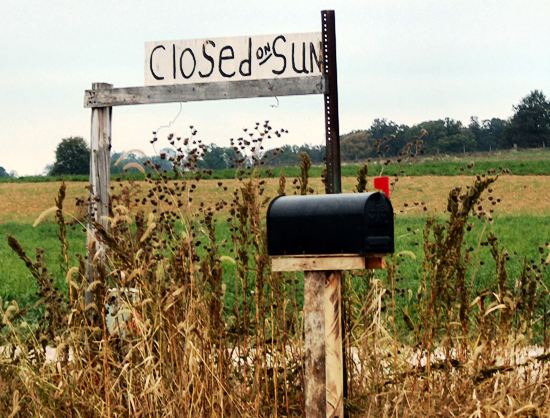The Three Amish Christmases
Did you know that Amish celebrate three separate Christmases? By this I mean three separate days called by some variation of the name “Christmas”. Two of them occur in December, and one in January.

Christmas (December 25)
First of course, there is the Christmas we all know, on December 25th. This is the official Christmas, the traditional commemoration of Jesus’ birth, and is celebrated in ways similar to those of non-Amish people – food, family, and visiting.
Experiences may vary, but church service (normally held on Sunday, once every two weeks) is typically not held on that day, though the birth of Christ will be covered in the worship gatherings held around this time. In the lead-up to Christmas, there are other Christmas events as well.

Parents and siblings attend Amish children’s school programs, a mix of songs, poems, and skits. I had a chance to visit one this year in Lancaster County, which lasted close to two hours. If you listen to the video below, the final minute contains audio from an Amish children’s Christmas program held earlier this week.
Children (and adults) may also go caroling. Yesterday, schoolchildren from two area schools were caroling in the neighborhood. A father of one of the scholars hauled the children around in a wagon drawn by two Belgian horses. Last year I went along with Amish friends who sang carols at several neighbors’ homes. Besides these, there are other ways Amish celebrate Christmas, detailed here.

Second Christmas (December 26)
The other two Christmases result from customs and events from long ago. First of all, Second Christmas (December 26) is celebrated by some Amish. This holiday has roots in observances in continental Europe. In the UK, Second Christmas is known as Boxing Day, while in other European countries such as Germany or Poland, it is St. Stephen’s Day.
This custom has been upheld by some Amish, but not all are aware of its roots. As one Amish woman observed, “I don’t know why it’s Second Christmas or where it started. But it’s so that you have another day to get together with your in-laws family…often we’re with friends at some point on that day too.”
Second Christmas is an opportunity to visit with in-laws, or with friend groups outside of your immediate family. For example, this year a friend of mine is planning to have his old youth group buddies over to his home on Second Christmas.

Old Christmas (January 6)
Finally, there is Old Christmas. That comes up on January 6. This also has roots in long-ago Europe. Specifically, the key event here is when Pope Gregory made a change to the calendar to account for a flaw in the Julian calendar:
The Gregorian calendar was decreed in 1582 by the papal bull Inter gravissimas by Pope Gregory XIII, to correct an error in the Julian calendar that was causing erroneous calculation of the date of Easter. The Julian calendar had been based upon a year lasting 365.25 days, but this was slightly too long; in reality, it is about 365.2422 days,[b] and so over the centuries, the calendar had drifted increasingly out of alignment with the Earth’s orbit.
The decree meant that countries adopting the calendar would remove a certain number of days from the calendar (around 10-13 days, depending when in history a given country adopted the change). Some Amish still keep observance of Old Christmas, which happens to fall on the same day as the Epiphany. It involves morning fasting, family and visiting.

It’s important to note that not all Amish celebrate all of these days. Some may observe Second Christmas, but not Old Christmas (such is the case in Lancaster County). In Holmes County, the Amish do celebrate Old Christmas, however.
You can also check out the video I made on this below. The Amish children’s program segment starts at about the 4:40 mark. And a Merry Christmas and Happy Holidays to you.





Merry Christmas!
Merry Christmas and happy new year to you too!
Thank you for sharing that, it is very similar to what we do too.
: )
Thank you Leana, glad you liked it! Hope you are having a great Christmas.
Merry Christmas!
You know, this actually isn’t that weird to me as a Catholic. Some Eastern Catholics celebrate Christmas on 6 January (although the Ukrainian Greek Catholic Church started celebrating this year on 25 December, some Orthodox in Ukraine also changed the date), and since, to me, Christmas (much like Easter) is a liturgical season, I celebrate it for a while. Fasting during Christmas season is a little different to me, but, to each their own.
Merry Christmas!
Yes I know some Ukrainians who have embraced the December 25 date as well lately. This would be in addition to the traditional Orthodox date so in essence I guess it extends the Christmas season. In other words we are still right in the middle of Christmas in some sense. Hard to find fault with that! Merry Christmas
Losstag or the little year
Hi Erik
Here in Alsace, December 26 is a public holiday while the rest of France works.
January 06 is celebrated as Epiphany Day.
For the record, the twelve days between December 26 and January 06 are called the Losstag or “s’kleine Johr” the little year. This is when the days are divided into 4 to represent the 4 weeks of a month. The weather is recorded in 6-hour increments: wind direction, temperature, rain, sun, etc.
December 26 is the month of January, December 27 is the month of February, … and January 06 is the month of December. This gives us an idea of what the weather will be like throughout the New Year. In a rural and agricultural world, this belief was important for knowing the weather to prepare harvests, ploughing, sowing, etc.
I’d have to ask my Mennonite friends, but I think their grandparents (Amish) also had to make this statement.
This tradition has slowly been lost. As for me, I write down the weather every Losstag and I come across an accuracy of 70%. An elderly local man, who specializes in this art, is even interviewed every year by the local press to give his forecasts.
But I don’t know if it works in America. 🙂